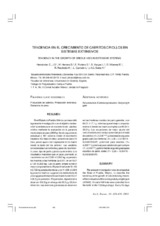Mostrar el registro sencillo del ítem
Tendencia en el crecimiento de cabritos criollos en sistemas extensivos
| dc.contributor.author | Hernández Zepeda, J.S. | es_ES |
| dc.contributor.author | Carreón, L. | es_ES |
| dc.contributor.author | Herrera García, M. | es_ES |
| dc.contributor.author | Reséndiz, R. | es_ES |
| dc.contributor.author | Villarreal, O. | es_ES |
| dc.contributor.author | Vargas López, Samuel | es_ES |
| dc.contributor.author | Rodero Serrano, E. | es_ES |
| dc.contributor.author | Sierra Vázquez, A. | es_ES |
| dc.date.accessioned | 2010-04-08T07:23:01Z | |
| dc.date.available | 2010-04-08T07:23:01Z | |
| dc.date.issued | 2005 | |
| dc.identifier.issn | 1885-4494 | |
| dc.identifier.uri | http://hdl.handle.net/10396/2859 | |
| dc.description.abstract | The present investigation was developed at the State of Puebla, Mexico, to describe the tendency in the growth of Creole kids by means of the evaluation of the average daily weight gain (ADWG). A total of 161 kids were controlled from the birth to the 102 days of age. Every 15 days the kids were weighed, previous fasting with separation of the mother from afternoon of the previous day. The variables included were date and weight at birth, sex, childbirth type and weights every 15 days. The results show that the average weight to the birth was 2.562 ± 0.583 kg, the males surpassing females (p<0.01) in 9.57 percent (0.232 kg). Differences were observed in favour of those of simple childbirth. The final weight was 10.186 ± 2.723 kg for the females and 11.508 ± 3.616 kg for the males. The males from simple childbirth reached a greater weight (12.229 kg). The average daily weight gain (g) for all the animals was of 82.37 ± 26.9 g. The weight at the first month reached 106.2 g; at the second 95.5 g and 53.9 g at third. The smaller gains are observed in the females born from double childbirth with 64.01 ± 17.1 g, whereas the best growth behavior was find in males from simple childbirth with 94.34 ± 30.31 g. The better adjustment of the growth was obtained with potential type equations for the total of kids (Y= 3.23X0.262); second degree polynomial equations were better for the females (Y= 3.35 + 0.07497X -0.00007085 X2); potential equations for males (Y= 4.23X0.21); and also, potential for kids of simple childbirth (Y= 3.91X0.23) and second degree polynomial equations for kids of double childbirth (Y= 3.26 + 0.0947X - 0.00002069 X2). | en |
| dc.description.abstract | En el Estado de Puebla, México, se desarrolló la presente investigación con el objetivo de describir la tendencia en el crecimiento de cabritos criollos mediante la evaluación de la ganancia media diaria de peso (GMDp). Se dio seguimiento individual a 161 cabritos desde el nacimiento hasta los 102 días de edad, pesándose cada 15 días, previo ayuno con separación de la madre desde la tarde del día anterior. Las variables consideradas fueron fecha y peso de nacimiento, sexo, tipo de parto y pesos quincenales. Los resultados muestran que el peso promedio al nacimiento es de 2,562 ± 0,583 kg, superando los machos a las hembras (p<0,01) en un 9,57 p.100 (0,232 kg). Los de parto simple tuvieron mejor comportamiento. El peso final fue de 10,186 ± 2,723 kg para las hembras y de 11,508 ± 3,616 kg para los machos. La ganancia media diaria de peso (g) para el total de los animales fue de 82,37 ± 26,9 g en promedio. Por períodos, al primer mes alcanzan 106,2 g; en el segundo 95,5 g y 53,9 en el tercero. Las menores ganancias se observan en las hembras nacidas de parto gemelar, con 64,01 ± 17,1 g, mientras que el mejor comportamiento lo tienen los machos simples con 94,34 ± 30,31g. Las ecuaciones de mejor ajuste del crecimiento fueron de tipo potencial para el total de cabritos (Y= 3,23X 0,262); polinomial de segundo grado para las hembras (Y= 3,35 + 0,07497X - 0,00007085X2); potencial para machos (Y= 4,23X 0,21); potencial para cabritos de parto simple (Y =3,91X 0,23) y polinomial de segundo grado para cabritos de parto doble (Y= 3,26 + 0,0947X - 0,00002069X2). | es_ES |
| dc.format.mimetype | application/pdf | es_ES |
| dc.language.iso | spa | es_ES |
| dc.publisher | Universidad de Córdoba, Servicio de Publicaciones | es_ES |
| dc.rights | https://creativecommons.org/licenses/by-nc-nd/4.0/ | es_ES |
| dc.source | Archivos de zootecnia 54 (206-207), 429-436 (2005) | es_ES |
| dc.subject | Producción extensiva | es_ES |
| dc.subject | Producción de cabritos | es_ES |
| dc.title | Tendencia en el crecimiento de cabritos criollos en sistemas extensivos | es_ES |
| dc.title.alternative | Tendency in the growth of creole kids in extensive systems | en |
| dc.type | info:eu-repo/semantics/article | es_ES |
| dc.relation.publisherversion | http://www.uco.es/organiza/servicios/publica/az/az.htm | es_ES |
| dc.rights.accessRights | info:eu-repo/semantics/openAccess | es_ES |

